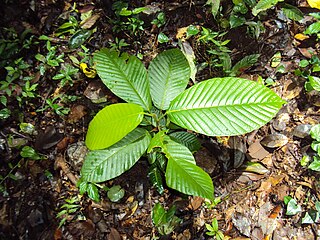
Dipterocarpus is a genus of flowering plants and the type genus of family Dipterocarpaceae.

Nepenthes reinwardtiana is a tropical pitcher plant native to Borneo and Sumatra and to a number of smaller surrounding islands including Bangka, Natuna, Nias, and Siberut. Although some sources have included Peninsular Malaysia and Singapore within the range of this species, these records appear to be erroneous.

Nepenthes angasanensis is a tropical pitcher plant species endemic to Sumatra, where it grows at an altitude of 1,400 metres (4,600 ft) to 3,100 metres (10,200 ft) above sea level. The status of this taxon is controversial as it is similar in morphology to N. mikei and N. tobaica. It has even been suggested that the taxon might represent a natural hybrid between N. densiflora and N. tobaica.

Nepenthes benstonei is a tropical pitcher plant endemic to Peninsular Malaysia, where it grows at elevations of 150–1350 m above sea level. The specific epithet benstonei honours botanist Benjamin Clemens Stone, who was one of the first to collect the species.
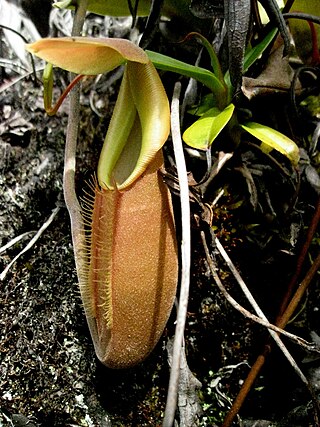
Nepenthes bongso is a tropical pitcher plant endemic to Sumatra, where it has an altitudinal distribution of 1000–2700 m above sea level. The specific epithet bongso refers to the Indonesian legend of Putri Bungsu, the spirit guardian of Mount Marapi.
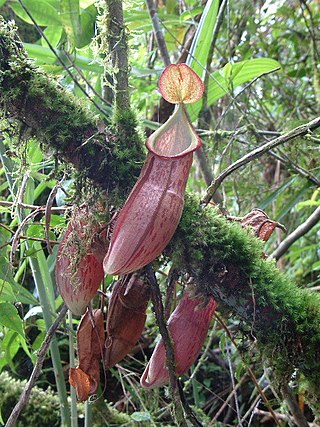
Nepenthes gymnamphora is a tropical pitcher plant native to the Indonesian islands of Java and Sumatra. It has a wide altitudinal range of 600–2,800 metres (2,000–9,200 ft) above sea level. There is much debate surrounding the taxonomic status of this species and the taxa N. pectinata and N. xiphioides.

Nepenthes dubia is a tropical pitcher plant endemic to the Indonesian island of Sumatra, where it grows at an altitude of 1600–2700 m above sea level. The specific epithet dubia is the Latin word for "doubtful".

Nepenthes densiflora is a tropical pitcher plant endemic to Sumatra, where it grows at an altitude of between 1700 and 3200 m above sea level.
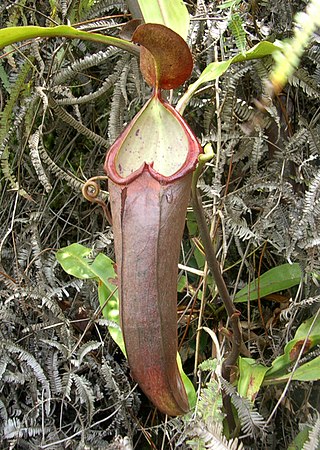
Nepenthes beccariana is a tropical pitcher plant. The species was described in 1908 by John Muirhead Macfarlane based on a specimen collected from the island of Nias, which lies off the western coast of Sumatra. It appears to be closely related to both N. longifolia and N. sumatrana, and the former is possibly a heterotypic synonym of this taxon.

Nepenthes junghuhnii is a tropical pitcher plant native to Sumatra. This species has been the source of much confusion since its discovery. The taxon originally named N. junghuhnii by John Muirhead Macfarlane has never been formally published. In 1994, taxonomist Jan Schlauer described N. junghuhnii as a "rather dubious species based on insufficient specimens". Nepenthes junghuhniisensu Macfarlane has not been relocated in the wild since the collection of the type specimen. It is characterised by strongly petiolate leaves and appears to be most closely related to N. bongso and N. spathulata; Schlauer considers it a possible synonym of the former.

Nepenthes × trichocarpa, the dainty pitcher-Plant, is a common natural hybrid involving N. ampullaria and N. gracilis. It was originally thought to be a distinct species and was described as such.

"The Nepenthaceae of the Netherlands Indies" is a seminal monograph by B. H. Danser on the tropical pitcher plants of the Dutch East Indies and surrounding regions. It was originally published in the Bulletin du Jardin Botanique de Buitenzorg in 1928, and reprinted by Natural History Publications (Borneo) in 2006.

Actinodaphne is an Asian genus of flowering plants in the laurel family (Lauraceae). It contains approximately 125 species of dioecious evergreen trees and shrubs.

Nepenthes × sharifah-hapsahii is a natural hybrid between N. gracilis and N. mirabilis. It has been recorded from Borneo, Peninsular Malaysia, Sumatra, and Thailand, although it was originally described as a species endemic to Peninsular Malaysia, where it was said to grow at elevations below 1000 m.
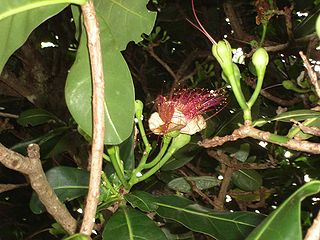
Barringtonia is a genus of flowering plants in the family Lecythidaceae first described as a genus with this name in 1775. It is native to Africa, southern Asia, Australia, and various islands of the Pacific and Indian Oceans. The genus name commemorates Daines Barrington.

Homalomena is a genus of flowering plants in the family Araceae. Homalomena are found in southern Asia and the southwestern Pacific. Many Homalomena have a strong smell of anise. The name derives apparently from a mistranslated Malayan vernacular name, translated as homalos, meaning flat, and mene = moon.
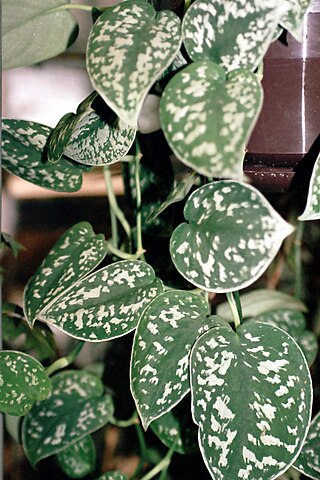
Scindapsus is a genus of flowering plants in the family Araceae. It is native to Southeast Asia, New Guinea, Queensland, and a few western Pacific islands. The species Scindapsus pictus is common in cultivation.
Anadendrum is a genus of flowering plants in the family Araceae. It is native to China and Southeast Asia.

"A skeletal revision of Nepenthes (Nepenthaceae)" is a monograph by Matthew Jebb and Martin Cheek on the tropical pitcher plants of the genus Nepenthes. It was published in the May 1997 issue of the botanical journal Blumea. The work represented the first revision of the entire genus since John Muirhead Macfarlane's 1908 monograph. Jebb and Cheek's revision was based on "collaborative work by both authors since 1984, largely on herbarium specimens, but including fieldwork in New Guinea, Indonesia, Malaysia, Singapore and Madagascar". It was a precursor to their more exhaustive 2001 monograph, "Nepenthaceae".

Hornstedtia is a genus of plants in the Zingiberaceae. It is native to Southeast Asia, the Himalayas, southern China, New Guinea, Melanesia and Queensland.


















